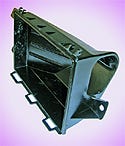May 8, 2007
Originally Published MPMN May 2007
OUTSOURCING OUTLOOK
Molding
Molding Services
|
Chuck Brewer III, CEO, C. Brewer Co., Anaheim, CA |
Leading healthcare companies can grow by strategically leveraging the outsourcing of their molding projects. It is important for them to choose the correct partner, since these contract molders will become an extension of their manufacturing capabilities. In turn, medical molders must become their OEM partners’ molding “alter ego.”
Successful contract molders have seamlessly assimilated a scientific approach to international product realization planning requirements in their validation, quality, and manufacturing disciplines. They recognize that medical device manufacturers need partners that apply technology and have a team of expert operators that can advance their systems.
Lean manufacturing, six sigma, VMI, kanban, and online auctions are all aggressive business practices. But chasing these solutions without a vigilant commitment to a quality policy leaves companies and people at risk. As OEM partners, our systems must rival those whom we serve; therefore complying with the ISO 13485 standard is the new benchmark. The regulation emphasizes software and process validation, demands a formal containment procedure for product recalls, and has a keener focus on product realization than the 9000 standard.
This commitment to quality translates into a molding partner that has implemented scientific molding practices and has procedures to demonstrate it—in short becoming the OEM’s alter ego.
Firm Has Expertise in Molding Engineering-Grade Thermoplastics
|
An FDA-compliant, ISO 9001:2000-, and ISO 13485:2003-certified supplier has expertise in molding engineering-grade thermoplastic and elastomeric materials and liquid silicone injection molding. Its capabilities include complete design and engineering services, a dedicated research and rapid prototyping department, in-house CAD/CAM-based tooling design and fabrication, insert molding, overmolding, white room molding, and Class 100,000 and Class 10,000 cleanroom assembly. The firm’s other contract manufacturing services include assembly, machining, welding, decorating, packaging, and sterilization management.
Donatelle, New Brighton, MN
www.donatelle.net
Injection Molding, Silicone Molding, and Assembly Services Offered
A full-service medical molding facility has 35,000 sq ft for manufacturing and a Class 100,000 cleanroom. The company offers a turnkey tooling solution provided by its sister company, and its expertise is in LIM applications of medical-grade silicones. Reportedly, it is the largest single-source supplier of devices requiring thermoplastic and silicone parts in the Western United States. Arburg injection molding machines and 2KM systems are used. Automation and runner technologies produce scrap-free, labor-free medical parts. Complete services from engineering support on tool design through final production validation are available.
Apec USA, Baldwin Park, CA
www.apecplastics.com
Insert Molding Is Available for Many Applications
|
A manufacturer specializing in insert molding of engineering-grade thermoplastic and liquid silicone rubber offers in-house design and engineering services, rapid prototyping, and mold designing and building. A one-stop shop, the firm handles secondary assembly including laser marking, pad printing, hot stamping, ultrasonic welding, packaging, and product sterilization. The customer’s design ideas can be taken from concept to completion within one vertically integrated facility. The company is FDA registered, ISO 13485 certified, and has a Class 100,000 cleanroom.
Remington Medical Inc., Alpharetta, GA
www.remmed.com
Full-Service Firm Uses Parametrics to Increase Accuracy of Molded Medical Components
|
Using parametric fundamentals of design, a company creates mold tool design models that have complete associativity throughout all of the different components of an assembly. Both major and minor changes to a product can be made and reviewed with the customer throughout all stages of the design and building of a precision injection mold. Design changes are communicated electronically in real time to the machine programmers who are shaping the steel.
Tech Tool & Mold Inc., Meadville, PA
www.ttmp.com
Molder Specializes in Controlled-Environment Manufacturing
An FDA-registered and ISO-compliant contract manufacturer and injection molder offers services such as horizontal thermoplastic injection molding to 85 tn, vertical liquid silicone rubber injection molding, and rotary insert injection molding. The company also offers product development, process development, and mold design services. Custom assembly, bonding, high-volume pad printing, and custom packaging capabilities are available as well.
Excel Medical Products LLC, Fenton, MI
www.excelmedicalproducts.com
Molder Adds Low-Pressure and Low-Temperature Services to its Capabilities
|
Low-pressure molding is a manufacturing process that falls between injection molding and potting. The process involves injection molding at very low pressures with hot-melt adhesives. According to the company, it is a cost-effective alternative to epoxy potting for protection of fragile electronic components. Benefits that the process provides to medical device manufacturers include complete sealing of the components, providing watertight encapsulation; effective strain relief; the use of low-viscosity materials that allow for low injection pressures of 30 to 300 psi; and gentle premolding of connectors. Components and wires are not damaged or dislocated in cavities, and fragile components are encapsulated easily.
Polymer Technology Corp., Menomonie, WI
www.polymertechnology.com
Molding Process Benefits Short Production Runs
|
A patented process is suitable for short production runs of 1 to 20 simulated rubber parts. The resulting urethane molded parts replicate the durometer and heat resistance of production parts. The Magcore process is touted by the company as an economical alternative to steel tooling. The mold pattern is created from customer-supplied CAD data, and is developed using an SLA model or cut on a CNC system, depending on which is the faster option. Other components can be easily added after the molded part is removed from the mold. Rubber molded parts of almost any configuration can be made, which is especially beneficial for prototype development or low-volume production requirements. Typical turnaround time from finished CAD to first article samples is 2 to 3 weeks.
Magnum Manufacturing Inc., Westland, MI
www.magnum-mfg.com
Copyright ©2007 Medical Product Manufacturing News
You May Also Like








